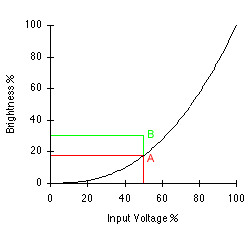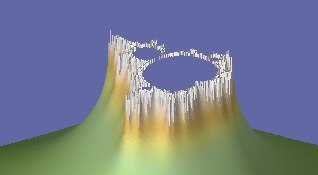|

|

|
Prints from Film
These prints are the most like traditional photographs, and require either a negative or a transparency of the image. The transparency (typically a slide) is a positive image; looking at the slide shows you the same image as you saw on the monitor. Negatives reverse the color, so something that was blue on the monitor will be orange on the negative. The advantage of using negatives is that they can be printed by any “one-hour” minilab. Transparencies, on the other hand, can usually only be printed by a photo lab. However, the quality of a good print directly from a transparency far exceeds that from a negative provided Ilfochrome Super Gloss paper (known for a long time as Cibachrome) is used (and perhaps a few others like Fuji Super Gloss reversal paper), but these prints are expensive. Prints from transparencies made on usual papers give generally poor results.
For quick, inexpensive prints, photographing the monitor is one option, and you can use print or slide film. For higher quality negatives or transparencies, consult a service bureau or a professional photo lab. A photo lab will use either a film recorder or a digital imaging system to expose the film. A film recorder is essentially a high quality monitor on which the image is shown, and then photographed. The digital route typically involves your providing a high-resolution render of your fractal image to the service bureau which will then use a machine like the Kodak LVT. The LVT uses lasers to expose each pixel of the image directly onto the film, without using a monitor. Consequently, LVT films can be of higher resolution than recorder films, and suffer no distortion due to the geometry of the monitor.
Once you’ve gotten your film exposed and processed, you have to entrust it to a photo lab for printing. Unfortunately, this step is critical to getting good prints, and is one over which you may have relatively little control. It will be important to find a photo lab with whom you can work and who will take direction. If possible, you should have a color guide to show the printer how the colors should look.
Low(er) Cost Photographic Prints
We have found websites from which you can order prints of your digital images on photographic paper. A web search on “digital photography labs” should turn up several. Some of these websites offer online albums from which your friends and family can order copies of your prints and at least one offers greeting cards and other gift items emblazoned with your images.
Archival Quality Digital Photographic Prints
In this method, lasers directly expose the photographic paper without any intermediate film. The final print quality compares favorably with traditional photographs, and the print lifetime should also be many decades. An advantage of digital prints is that a negative or transparency is not needed. Current machines print at 200 dpi, which means that your print will have a maximum of 200 pixels per inch, but because the paper is exposed with continuous tone rather than dots, this produces a beautiful print. Newer printers reportedly print up to 400 dpi, but, according to Damien Jones the difference at 400dpi is very slight.
|

|
![]()
![]()

